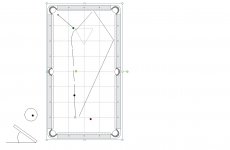I was playing earlier and came across this shot. First I grabbed my jump cue. Then I noticed it was a full ball jump over the 8 ball and then I would be hitting the 6 ball on the wrong side. I told my friend I'll just masse the shot a little.
What would you say the difficulty of this shot is?
What would you say the difficulty of this shot is?
